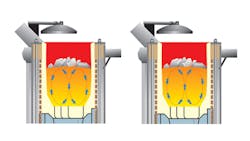A metalcasting operation demands a lot of choices from operators and managers, from quick-response decisions to consequential investment plans. Often, compromises have to be made. Fortunately, in the selection of melting technology, there is a choice available that will prioritize several metalcasting goals.
Higher quality metal. Induction technology heats metal/materials directly. Since the metal in an induction melting furnace generates the heat in the metal itself, there are no hot spots anywhere in the furnace. This homogeneous temperature of the metal and refractories promotes reduced hydrogen pick up and oxidation of the metal compared with alternative methods of melting. This leads to higher quality metal with lower levels of inclusions and porosity. Reduced porosity and reduced inclusions means less time and expense is spent removing waste oxides from the furnace, lowering labor cost.
The electromagnetic forces induced by induction melting stir the bath. This constant motion forces the inclusions to join together, for easier removal and much cleaner metal. This motion also promotes a more complete mixing of alloying materials, which is essential for applications requiring a high degree of alloy consistency.
Uni-directional forced stirring of metal is available in applications requiring more enhanced refining.
Induction technology can help metalcasters produce higher quality metal/material more profitably. Induction melting is clean, quiet and has a high productivity rate. Induction furnaces use a non-radiant energy transfer process. Electricity heats the charge, not the melt shop. And there is no combustion noise, which means fewer distractions for a safer melt shop. For maximum productivity and safety, your furnace can be equipped with an automated charge preheating or drying system and a material handling system. Optional lining push-out systems put your furnace back on-line faster.
More efficient energy usage. Induction melting has lower energy costs than all other types of melting. In many parts of North America, induction furnaces are the most efficient way to melt most metals and materials. For example, Inductotherm’s coreless furnaces achieve higher energy efficiency as compared to gas-fired furnaces because they are matched with the VIP® induction power supplies designed for a specific melting or heating application.
Lower metal costs. With induction melting, metal loss can be as low as one half of one percent (0.5%). As an example, recycled aluminum scrap can be used in some applications that previously required primary or secondary ingot. This also reduces the cost of the charge material. The electromagnetic stirring action rapidly submerges the recycled scrap charge, promoting more rapid melting while reducing oxidation of the charge before it melts. Coreless induction furnaces are particularly cost-effective for melting chips and turnings.
Robert Keshecki, Jr., is the international sales manager for Inductotherm Corp. Contact him at [email protected]
About the Author
Robert Keshecki
Director of International Sales
Robert Keshecki is Director of International Sales at Inductotherm Corp. Contact him at [email protected], or visit www.inductotherm.com

